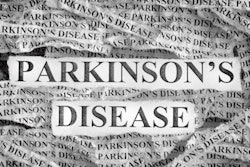
Higher white-matter hyperintensity (WMH) visible on MRI scans in older adults is associated with more rapid progressive parkinsonism, according to research released on November 1. That association remained statistically significant despite partial attenuation in a model including postmortem indices of cerebrovascular disease brain pathologies.
A community-based cohort study led by Dr. Shahram Oveisgharan from Rush Alzheimer's Disease Center at Rush University Medical Center in Chicago conducted postmortem autopsies as well as ex vivo brain MR imaging. They found higher levels of both white-matter hyperintensity and indices of cerebrovascular disease pathologies in aging brains were associated with more rapid progressive parkinsonism (JAMA Neurology, November 1, 2021).
"These longitudinal findings support a notion that both WMH and cerebrovascular disease pathologies may be underestimated independent contributors to progressive parkinsonism, which is common in older adults," he and his colleagues wrote.
Parkinsonism is a constellation of four signs: parkinsonian gait, bradykinesia, tremor, and rigidity. It affects approximately half of community-dwelling older adults without a clinical diagnosis of Parkinson's disease. It's not benign and is associated with several adverse health outcomes such as disability, falls, dementia, and death.
And even though the link between cerebrovascular disease brain pathologies and a faster progression of parkinsonism is growing stronger, the contribution of WMH hasn't been examined -- until now.
The research team included 4,427 participants recruited in three ongoing cohorts that began enrollment in 1994, 1997, and 2004. Participants were observed for a mean of 7.5 years with annual clinical assessments. Oveisgharan and colleagues performed postmortem autopsies in 1,725 decedents, and 598 also had ex vivo brain MR imaging.
One brain hemisphere was frozen and the other was fixed in a 4% formaldehyde solution, after which a brain MRI scan was obtained using one of four 3-tesla MRI scanners: GE Signa (GE Healthcare), Magnetom Trio (Siemens Healthineers), Philips Achieva (Philips Healthcare), and Magnetom Verio (Siemens Healthineers).
Each brain had two MRI sequences: 2D fluid-attenuated inversion recovery (FLAIR) and 2D multiecho spin echo with images that were intensity-normalized for further processing.
"One of the novel aspects of this study is that MR imaging was conducted in brain hemispheres ex vivo at the time of autopsy while immersed in formaldehyde solution," the researchers wrote. Because of this, "none of the publicly available software for segmenting and quantifying WMH could be applied."
To work around that problem, the team used visual rating of WMH burden -- a trained rater examined FLAIR and T2-weighted images to separately rate WMH burden as either none or mild, moderate, or severe.
The group found almost half of participants (244, 47.3%) had severe WMH burden, more than one-third (181, 35.1%) had moderate, and 91 (17.6%) had no to mild levels. Older adults, women, and those with a history of stroke were more likely to have more severe WMH, according to the researchers.
"Moderate to severe WMH was more common than any other examined pathology, including [Alzheimer's Disease], cerebrovascular disease pathologies, [Parkinson's Disease] pathology, or hippocampal sclerosis, and WMH tended to coexist with other pathologies," they wrote.
Furthermore, in a linear mixed-effects model controlling for demographic characteristics, the severity of parkinsonism increased by about 0.13 units per year and more severe WMH was associated with more rapid progressive parkinsonism (p = 0.002).
However, more studies are needed all around -- for instance, to identify the specific brain regions associated with parkinsonism, and to determine if in vivo imaging plus aggressive medical treatment of vascular risk factors and diseases can affect parkinsonism.
"The current findings may have important consequences for both aging research and the clinical care of older adults with late-life motor impairment," the authors concluded.



.fFmgij6Hin.png?auto=compress%2Cformat&fit=crop&h=100&q=70&w=100)




.fFmgij6Hin.png?auto=compress%2Cformat&fit=crop&h=167&q=70&w=250)











